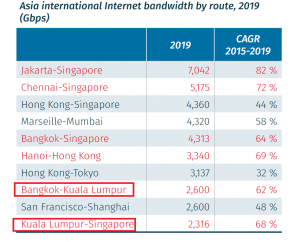
According to latest statement, DE-CIX in its new white paper on the interconnection potential of the ASEAN demonstrates that Malaysia is set to become a sub-regional interconnectivity hub
With excellent international and terrestrial connectivity to the rest of Southeast Asia and beyond, Malaysia has the potential to complement the major content hub of Singapore by providing regional interconnection for growing local needs.
The white paper entitled “New interconnection markets in Southeast Asia”, released exclusively via a virtual press conference today, was commissioned by DE-CIX and researched and written by the neutral telecommunications analyst TeleGeography. In the white paper, TeleGeography highlights that over the years, an excessive dependence on Singapore as the regional and global hub has developed for some networks in the region, resulting in an increasing demand for more widely distributed carrier and data center neutral interconnection infrastructure. This development creates opportunities for at least five frontier markets in the region – Kuala Lumpur, Jakarta, Bangkok, Manila, and Hanoi.
The demand for interconnection in Southeast Asia is growing rapidly. Some international operators have become overly dependent on Singapore for connectivity in Southeast Asia. Therefore, the movement toward an interconnection platform that spans multiple markets in the region – creating a Southeast Asia wide interconnection ecosystem – is a natural step, as other parts of the world have gone through a similar transformation. This shift will not reduce the need for strong hubs like Singapore, but rather supplement that need with greater edge peering, networking, and computing resources. This paves the infrastructure path for content and applications to get as close as possible to the users in their offices and their homes, increasing the quality of experience,” said Ivo Ivanov, CEO of DE-CIX International.
The findings of the white paper demonstrate the rising demand for network interconnection localization on a sub-regional level. The key reasons for this expansion include:
Network concentration in one city is not ideal to ensure reliable service in volatile situations
The high colocation costs in Singapore (25% pricier than New York’s average price per kilowatt)
Operational uncertainty in the other regional hub market, Hong Kong, due to political instability
Nascent markets in Southeast Asia have rapidly growing demand for international bandwidth, saturated telecommunications markets, and an appetite for local interconnection.
On top of that, the report has identified Kuala Lumpur to be part of two of the top ten largest Internet routes in Asia, both of which have been accumulating international Internet bandwidth at more than 60 percent Compounded Annual Growth Rate (CAGR) since 2015. The presence of major cloud providers in Kuala Lumpur clearly indicates a demand for a strong interconnection ecosystem in this market, while the increasing cloud activity in Jakarta and Kuala Lumpur conveys immediate potential.
Mr. Weng Yew Wong, Board of Management of DE-CIX Malaysia and Singapore said: “The white paper reveals that the Southeast Asian markets are already highly interconnected and possess regional self-reliance. With the DE-CIX Asia interconnection ecosystem, all DE-CIX’s existing and future IXs in Southeast Asia will be interconnected. Connected customers at any of the exchanges will be able to immediately access networks at any of the other DE-CIX IXs in the region. This will provide a seamless connection, top quality interconnection services, and the most cost-effective way to peer across Southeast Asia.”
Weng added that DE-CIX has a proven record of accomplishment in successfully creating interconnection hubs worldwide. Its customers and partners include not only global hyperscalers, streaming service providers and network providers, but also automotive manufacturers and local and regional cloud service providers.
“As DE-CIX works to create an Asia-wide ecosystem of interconnected markets, smaller markets will increasingly pick up speed. DE-CIX Malaysia, as a part of DE-CIX Asia, will meet the demand for high quality interconnection, and help the Malaysian market to grow further as aspired to in the country’s digital transformation plan.”
Announced in late 2019, DE-CIX and the local Malaysian Internet Exchange provider JBIX created the joint venture DE-CIX Malaysia, which currently runs two Internet Exchanges in the greater Kuala Lumpur and the Johor Bahru region. DE-CIX is to open further Internet Exchanges in Southeast Asia in due course.
The full white paper “New interconnection markets in Southeast Asia” can be found here.

